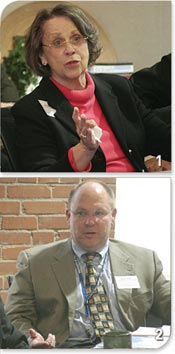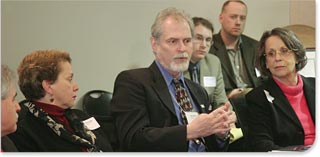For the University of Kansas, Scott Weir noted, the number one priority is to establish an National Cancer Institute (NCI) designated comprehensive cancer center. The first step in that process is NCI designation as a “cancer center.” The goal for this designation is 2010. The goal for “comprehensive cancer center” status is 2016.
“What [comprehensive status] means,” said Weir, “is cutting-edge research in the area of cancer, both basic research as well as clinical research.” Weir estimated a $1.3 billion economic impact in the region in the first year alone, 2016.
“The idea being,” clarified Bill Duncan, “that at the end of the day, when somebody is diagnosed with cancer, they don’t have to pick up and go to Mayo or wherever.”
Duncan commented that the Department of Homeland Security had asked for proposals for a national bio and agro-defense facility, so called NBAF. Of all the submitted applications, 18 have made the cut, including one from the University of Missouri and another from K-State.
“This is a unique opportunity,” said Jim Guikema. In essence, this will be a research facility designed for the safe conduct of research on diseases and critical animal health issues.
“From a communications standpoint,” commented Linda Cook. “These locations will require a lot of support from all the constituents because there will be opponents to this type of activity going on in their area.” It is in situations like these that a unified life sciences effort can bear fruit. “There’s got to be a significant public outreach program,” affirmed Duncan.
Recruitment

1: University of Kansas Medical Center administrator Joan Hunt works as a bridge-builder within the KU system to bring science to the forefront of the university’s mission.
2: Scott Weir of KU discussed strategy to position the medical center as a NCI-designated Cancer Center.
There was obviously a good deal of enthusiasm among the group about new facilities, but Lesa Mitchell wondered whether there was as much emphasis on recruiting “really great people” for those buildings. “I am probably the last person who should be encouraging us to recruit rock star scientists,” said Mitchell, “but I would encourage us to recruit rock star scientists.”
Jim Guikema contended that K-State does have a “track record of getting good, young people, high-quality investigators that are on the onset of their careers.”
“Rising stars,” added Bill Duncan. “Not rock stars yet.”
Joan Hunt acknowledged that area institutions have to “offer more” to attract up and comers. She was referring not just to money but to the opportunity for innovation and leadership. “The medical center has been hugely successful in this,” she noted, hiring some 23 research scientists in the last year alone.
In the private sector, observed Sean Hart, recruiting is a little easier, “because the funding is there to make things happen.” What he has witnessed on the tech side is a given area pooling resources and approaching the marketplace with a coherent message. “I wonder if we have created a single message,” he said of the Kansas City region. “I don’t know if we have done enough.”
“One of the things that we have benefited from,” said Jeff Biskup,” being a Midwest company, a company that grew up in Kansas City and has expanded from there is that our culture is based on a Midwest work ethic and our business style is very much known as smart guys that work hard.”
“We hear that all the time from companies that are considering here,” confirmed Duncan. He cited some statistics to show how the combination of work ethic and life science promotion through KCALSI “without question is having an impact on the region and our ability to recruit, attract companies on a regional basis.”
Animal Health
Bill Duncan sees the NBAF as “a seminal opportunity for us as a region.” As Duncan noted, some 30% of the global animal health market is generated by the greater Kansas City region. The NABF would seem a natural fit.
“There are so many aspects of biotechnology and the life sciences where we can wear the white hat,” said Kelly Gillespie. “Why not put animal health out front where it is a unifier for both sides of the state line and one that is going to pull Missouri and Kansas even stronger together?”
Jeff Biskup saw a further advantage in the region’s status as an animal health center. As he pointed out, animal health producers are doing their bioprocess manufacturing much more efficiently than are most of the human biopharmaceutical manufacturers. This may well attract those generic human health manufacturers looking for an efficient, low cost environment.
 Jim Guikema of K-State reported on the many scientific advancements occurring in Manhattan.
Jim Guikema of K-State reported on the many scientific advancements occurring in Manhattan.Mike Chippendale argued the veterinary schools, the animal science schools, K-State and MU, to step up and underpin future developments in animal health with the necessary research. “This is one side of it that we’ve got to look at closely,” said Chippendale.
“I think it’s clear that innovation in the animal health companies is just as important as it is on the human side,” said Duncan, arguing from an economic development perspective.
(...continued)